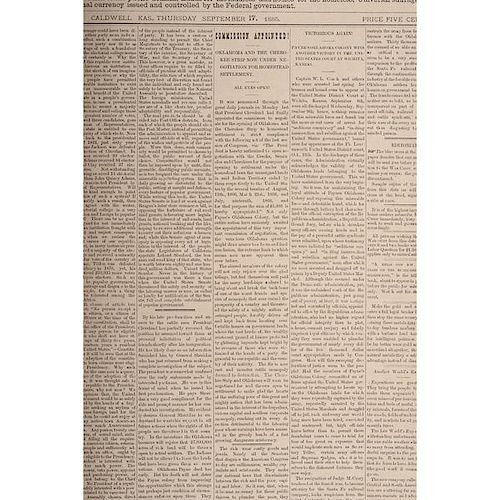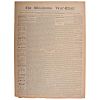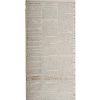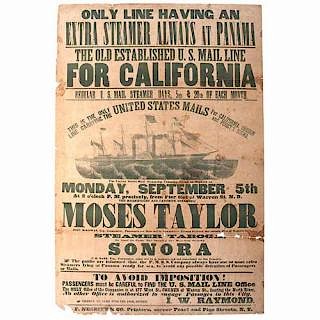Oklahoma War Chief, Very Rare Newspaper Dedicated to Opening of Indian Territory to White Settlers, 3 Issues, 1883-1885
About Seller
6270 Este Ave.
Cincinnati , OH 45232
United States
With offices in Cincinnati, Cleveland and Denver, Cowan’s holds over 40 auctions each year, with annual sales exceeding $16M. We reach buyers around the globe, and take pride in our reputation for integrity, customer service and great results. A full-service house, Cowan’s Auctions specializes in Am...Read more
Two ways to bid:
- Leave a max absentee bid and the platform will bid on your behalf up to your maximum bid during the live auction.
- Bid live during the auction and your bids will be submitted real-time to the auctioneer.
Bid Increments
| Price | Bid Increment |
|---|---|
| $0 | $25 |
| $500 | $50 |
| $1,000 | $100 |
| $2,000 | $250 |
| $5,000 | $500 |
| $10,000 | $1,000 |
| $20,000 | $2,500 |
| $50,000 | $5,000 |
| $100,000 | $10,000 |
About Auction
Jun 10, 2016 - Jun 11, 2016
Cowan's Auctions dawnie@cowans.com
- Lot Description
Oklahoma War Chief, Very Rare Newspaper Dedicated to Opening of Indian Territory to White Settlers, 3 Issues, 1883-1885
Lot of 3 issues of the Oklahoma War Chief, each printed in a different town along the Kansas-Indian Territory border between 1883 and 1885 by David L. Payne in order to promote the goal of the opening of the Cherokee Indian Strip (Indian Territory; present-day Oklahoma) to white settlement. Oklahoma Boomer Movement leader, David L. Payne founded the Oklahoma War Chief newspaper to agitate for the opening of the unassigned lands to homesteading. The paper was first published at Wichita, KS in 1883, and after several moves to towns along Kansas' southern border, Payne moved the printing press to Rock Falls in the Cherokee Outlet in 1884 where he hoped to establish a colony. On August 7, 1884, the US Army arrested the colonists and confiscated the press. The "boomers" bought a new press and continued publishing the Oklahoma War-Chief (now hyphenated) at South Haven, KS until Payne's death in November 1884. It was published in Caldwell, KS after Payne's death. Each issue carries feverish editorials and news regarding Payne's settlement cause as well as national news. The following issues are included in the lot:
Oklahoma War Chief, Geuda Springs, KS, Official Organ of Payne's Oklahoma Colony, KS, June 7, 1883. 4pp, approx. 16.5 x 22 in.; Oklahoma War Chief, South Haven, KS, November 13, 1884. 4pp, 16.5 x 23 in.; and Oklahoma War-Chief, Caldwell, KS, September 17, 1885. 4pp, 17 x 23.75 in.1883 issue: with the exception of areas near the top and bottom left edge, the newspaper is almost fully separated at the fold; horizontal fold at center reinforced with Scotch tape on front page, some of the edges reinforced with Scotch tape; some chipping and loss along edges, with loss at top left corner of front page; chipping and loss especially along left edge, some scattered stains/spots; it appears that newspaper was previously trimmed along top and right edges.Condition
1884 issue: newspaper appears to have lightened; few tears and/or small holes at fold; horizontal and vertical creases in issue, with remnants of tape previously used along horizontal folds noticeable; some short tears, chips along perimeter of each page; some scattered spots.
1885 issue: very good condition overall, with few short tears, some chipping along perimeter of each page, including a short diagonal tear that starts along bottom edge and extends into fifth column text; margins slightly darker in tone. - Shipping Info
-
SHIPPING. At the request of the buyer, Cowan's will authorize the shipment of purchased items. Shipments usually occur within two weeks after payment has been received. Shipment is generally made via UPS Ground service. Unless buyer gives special instructions, the shipping method shall be at the sole discretion of Cowan's Auctions, Inc.. Cowan's is in no way responsible for the acts or omissions of independent handlers, packers or shippers of purchased items or for any loss, damage or delay from the packing or shipping of any property.
-
- Buyer's Premium



 EUR
EUR CAD
CAD AUD
AUD GBP
GBP MXN
MXN HKD
HKD CNY
CNY MYR
MYR SEK
SEK SGD
SGD CHF
CHF THB
THB













